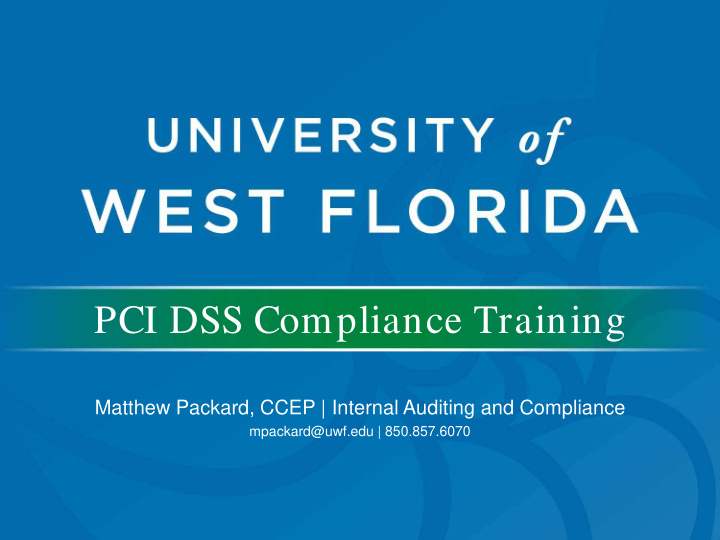



PCI DSS Compliance Training Matthew Packard, CCEP | Internal Auditing and Compliance mpackard@uwf.edu | 850.857.6070
Agenda ☸ PCI DSS overview ☸ The Basics ☸ Your responsibilities ☸ University Policies ☸ Best Practices
So… what is PCI-DSS? P ayment C ard I ndustry D ata S ecurity S tandards • Created by the PCI Data Security Council (Visa, MasterCard, American Express, Discover, and JCB) • Created a common set of industry standards developed to increase the controls around cardholder data to reduce credit card fraud. • These standards consist of 6 goals and 12 Requirements…
PCI DSS Standards 6 Goals 12 Requirements
Why am I here???
Background Information Over the past few decades… • Increases in payment card usage • Increases in e-commerce • Increases in more “convenient” payment methods
Background Information Continued In our desire for convenience, we have left ourselves vulnerable
PCI DSS @ UWF As a public institution we have a obligation to our students, vendors, donors, stakeholders, and the community at large to ensure that there account information is safe when processing credit card payments @ UWF
PCI DSS—It Can Help Prevent Data Breaches!
Non-Compliance—What’s at Stake Could result in the revocation of our ability to accept card payments Causes damage to consumer trust and our reputation Fines our acquiring bank $5,000 to $100,000 per month* $7.01 million = Average organizational cost of a data breach** *The bank will likely pass this fine along… **2016 Cost of Data Breach Study: Global Analysis, Ponemon Institute
Agenda • PCI DSS overview • The Basics • Your responsibilities • University Policies • Best Practices
The Basics: Credit Card Anatomy (Front) EMV Chip Holographic Security Emblem Account Number Expiration Date Card Logo Cardholder’s Name
The Basics: Credit Card Anatomy (Back) Magnetic Stripe Security code also known as CVV2/CID*/CAV/CVC2 Signature Panel The magnetic stripe contains CH name/address; account #; expiration date; and security information to detect fraudulent cards *American Express refers to this code as the CID and it is located on the front of the card
What is Cardholder Data (CHD)? … technically Primary Account Number (PAN): Consists of the full credit/debit card number CHD consists of the PAN plus any one of the following: Cardholder Expiration Security Code name date
The Last 4 Digits Customer receipts should not show more than the last four digits of the Storage of the last credit card number four digits of a credit card number is allowed & does Computer systems and not constitute CHD software used to process credit card transactions should not display more than the last four digits of the credit card number
Cardholder Data Procedures: Magnetic Stripe/ PIN/ Code The University does not permit the storage of the codes found on the magnetic stripe, PIN/PIN block data, or the card validation code.
Cardholder Data Procedures: Access Control All employees that have access to CHD must keep this information in the strictest confidence, and protect it from unauthorized access or disclosure. Access to this information should be on a need-to-know basis only.
Cardholder Data Procedures: Electronic Records CHD should NEVER be stored in electronic format* CHD should NEVER be included in email or other electronic messages *Entering CHD into e-market portals (Lumens/HigherOne/CashNet/etc.) does not qualify. As this data is not being stored on our campus network.
Cardholder Data Procedures: Paper Records Procedures Paper documents must be protected, stored securely, and disposed of securely. If unavoidable, please refer Avoid the use of to the paper document standards/procedures paper documents provided on the UWF whenever possible. Financial Services PCI Compliance webpage.
Agenda • PCI DSS overview • The Basics • Your responsibilities • University Policies • Best Practices
Workstation Responsibilities Each workstation must be a dedicated, PCI Each user is required to have a unique login for compliant, ITS operating POS device approved payment machine Keep login credentials Secure the credit card confidential and do not environment from non share with others cashier personnel
Workstation Responsibilities Continued Log off another cashier and login with your Log off whenever own credentials stepping away from machine when processing transaction Keep your Turn off POS device workstation clear of at night and secure any sensitive area materials
Agenda • PCI DSS overview • The Basics • Your responsibilities • University Policies • Best Practices
UWF PCI DSS Policies
PCI DSS Security Policy Technologies NOT allowed to access the cardholder environment Open or public WIFI (non VPN) Removable electronic media (USBs, etc.) Laptops Tablets Smartphones
PCI DSS Security Policy Activities NOT allowed while accessing and/or connected to the cardholder environment Checking email Visiting any website not directly associated and pertinent to the actions being performed Make internet or intranet connections that are not explicitly necessary
Agenda • PCI DSS overview • The Basics • Your responsibilities • University Policies • Best Practices
Best Practices Maintain strong passwords and update regularly • Password Dos and Don’ts Be on the lookout for skimming devices • Familiarize yourself with the point-of-sale equipment and check regularly for modifications Be sure your station is physically secured at all times
Best Practices Continued Destroy CHD immediately* (cross-cut shredder) Notify the Compliance Officer or Financial Services immediately if there is a change in personnel Never send CHD via electronic messages/email Never share your login credentials Be on the lookout for phishing/social engineering attempts to steal your credentials • Avoiding phishing and social engineering attacks *Only write down CHD when absolutely necessary… it usually is not.
Questions? mpackard@uwf.edu | 850.857.6070
Recommend
More recommend